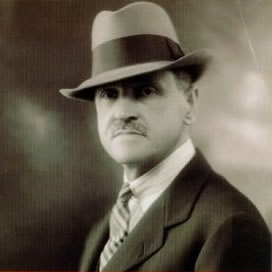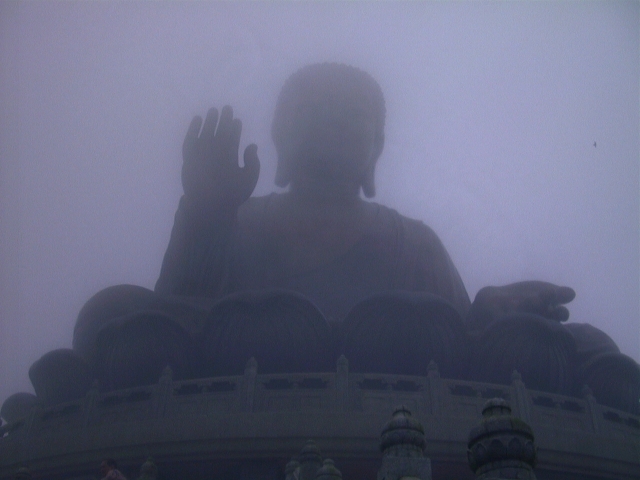FOOTNOTE [2]
THE RAZOR'S EDGE: Eye Contact Sequences

WILLIAM SOMERSET MAUGHAM
"I felt that there was something within him, I don't know whether to call it Maugham writes of Larry Darrell, post Enlightenment.
awareness or a sensibility or a force, that remained strangely aloof."
As has been mentioned previously in the main portion of the text, the eye contact experience between Darrell and Maugham that transpired at the Cafe Du' Dome in the spring of 1931 impacted Maugham in the extreme, and because of that, became a must write for the reader as well as the author.
The eye contact sequences may not seem like much to the casual purveyor of the Maugham novel --- and to my knowledge NEVER brought up or thought of as having any sort of import by most critics and reviewers of The Razor's Edge. However, I consider Maugham's observations and his attempts to clarify his own inner thoughts and feelings on the matter --- inturn so both he himself as well as the reader will have a better understanding of Larry Darrell and his Enlightenment --- to be of major importance, especially so because of my own personal experiences in similar areas. Nowhere in any of Maugham's works, plays, novels, or shortstories, does it show up that he he spent so much time emphasizing and presenting a similar sort of circumstance to the reader. It was not until he met with the Bhagavan Sri Ramana Maharshi personally in India did it get resolved. Up to that point he labored over it and over it, and for me, in the end, it is the single most important event --- in a whole overwhelming string of events --- that grabbed Maugham and sent him on his journey to India and meet with and talk to the Maharshi.
At the time, immersed in the center of it all himself, Maugham may have been naive to the importance of any eye contact sequence. However, throughout history, from unheralded, unknown incidents to classical events of major proportions, eye contact shows up regularly in a variety of spiritual encounters. In my own situation I can cite at least three instances that eye contact played a major role in a downstream spiritual unfolding beyond that of my first verbal encounter with my Mentor, described previously when I wrote:
"When we made eye contact for the first time I was set aback, almost stunned, by the overwhelming calmness and serenity that seemed to abide in his presence."
Before that, as an eight year old boy, in THE MEETING: An Untold Story of Sri Ramana, in an incident wherein I sum up the eye contact sequence between my mentor's teacher and myself I presented the following:
"He looked right into my eyes from a few feet away and somehow TIME SEEMED TO SLOW, maybe even stopping altogether. From far away I felt myself losing balance, all the while trying to brace myself with one arm while trying to hold the lantern high with the other. I weighed a ton and could barely move. In ultra slow motion the light, moving now at such an overwhelmingly reduced rate I could hear it, flickered and nearly went out. Then, just as the lantern reached the top arc of its swing and stilled to start back, the light rekindled itself. In that waffer-thin edge-on membrane of darkness the man was gone."
The above incident itself was a mirror-image replicate of an even earlier event and meant primarily to reinstigate a lost Awakening. To wit, as found in SRI RAMANA MAHARSHI: The Last American Darshan regarding that Enlightenment experience:
"A mere spark has ignited his spiritual fire. So, that casual look was a spark of tremendous power."
Again, here is Sri Ramana with no more than what is called a "casual look" that is inturn, from his look, a "spark of tremendous power."
As a ten year old, another eye contact incident similar to what happened at the stage stop occurred while traveling with my Uncle and his curandera wife. We had gone to a basically unknown at the time sacred Native American site now called Pendejo Cave and met with a tribal spiritual elder. The elder was comfortable with my uncle and his wife, but uncomfortable with me. After the curandera told him of my experience with several vultures deep in the desert one day, of which then, vultures eventually became my Totem Animal, the elder came over and looked intently into my eyes. Whatever he saw he apparently liked and I was allowed to continue to the sacred site.
The third occasion transpired many years later and found me as a grown man late one night high in the mountains of Jamaica in an encounter with an occult man of spells called an Obeah. Because I was a white man, the Obeah would not let me enter his hut...and at first refused to have anything to do with me. Mimicking almost the exact same thing that happend to me as a ten year-old boy at Pendejo Cave, the Obeah squated down without changing eye contact, peering at me with, in an almost scary comparison with what Carlos Castaneda says in an interview cited below, an astounding set of eyes that seemed to shine deeply from within with a mysterious, intense light of their own, and said, in his heavy Jamaican patois, "You have felt the breath of the Dark One." "Yes, once," I said, "many years ago," refering to an incident in the military when I literally felt the Shadow of Death brush across my soul. "Why didn't he take you with him," the Obeah asked? "I don't know," I responded, shrugging my shoulders.(source).
Bhagavan Sri Ramana Maharshi had only just moved from the caves on the side of the holy mountain to it's base and taken up residency at his newly constructed ashram, which was not much more than a thatched hut in those days, when he was visited by Swami Ramdas, a person on the cusp of great spiritual renown. About his experience Ramdas has said:
"The Maharshi, turning his beautiful eyes towards Ramdas, and looking intently for a few minutes into his eyes as though he was pouring into Ramdas his blessings through those orbs, nodded his head to say he had blessed. A thrill of inexpressible joy coursed through the frame of Ramdas, his whole body quivering like a leaf in the breeze."
In that ecstatic state he left Maharshi's presence to meditate in the caves on the slopes of Arunachala, then left on spiritual pilgrimage across India. One night in the Meenakshi Temple in Madura the person that Maugham used for Darrell, my mentor, inadvertently bumped into Ramdas. From that encounter, following the Swami's advice, the young American went to the ashram of Sri Ramana. (see).
In 1938, seven years after his talks with Darrell in Paris Maugham goes by ship to the sub-continent and Travels In India. His trip lasted three months, eventually visiting the ashrama of, and meeting with the Maharshi in person. On the first day at the ashrama Maugham passed by the room where Sri Ramana was seated with his devotees. He didn't enter because he was wearing big klunky boots and, because he was tired from his long journey, was not up to taking them off (you are not allowed in with boots or shoes on). Maugham simply peeked in and observed the scene, then went to his room. Ramana was aware of his visitor, and the next day went to Maugham's room for a private meeting. As was Ramana's practice, he simply sat in silence gazing at Maugham. Maugham became uneasy and nervous after the first few minutes and asked "Is there anything that I should be doing now. Is something supposed to happen?" (an understandable western apprehension and expectation) and apparently at some point Maugham became quite overcome and fainted. (source)
Several months later, an acquaintance of Maugham that traveled in the same circles, Mercedes De Acosta, was driven by an inner need to visit Sri Ramana. After she had been sitting in the meditation hall for several hours a fellow American, Guy Hague, who many people have said was the real life role model for the Larry Darrell character in Maugham's The Razor's Edge, suggested she go and sit closer to the Maharshi. He said, "You can never tell when Bhagavan will come out of Samadhi. When he does, I am sure he will be pleased to see you, and it will be beneficial for you, at this moment, to be sitting near him."
Although she didn't faint as Maugham did in the Maharshi's presence, in her book Here Lies the Heart she related the following, similar and equally strong eye contact experience:
I moved near Bhagavan, sitting at his feet and facing him. Not long after this Bhagavan opened his eyes. He moved his head and looked directly down at me, his eyes looking into mine. It would be impossible to describe this moment and I am not going to attempt it. I can only say that at this second I felt my inner being raised to a new level--as if, suddenly, my state of consciousness was lifted to a much higher degree. Perhaps in this split second I was no longer my human self but the Self.
Many, many years before either Maugham or De Acosta visited the ashram and reported the above experiences the Maharshi was visited by a man of deep spritual conviction by the name of Paul Brunton. Brunton, through his critically acclaimed book A Search in Secret India (1934), is considered to be the single most important person in the opening up to the west of the Bhagavan Sri Ramana Maharshi. In his book Brunton describes several instances of being highly impacted by eye contact sequences through the direct influence of the Maharshi. When Brunton first arrived at the ashram it seemed the holy man was in continual deep meditation called Samadhi. Although Brunton expected something to happen, for him he writes: "the minutes creep by with unutterable slowness." In the end, however, the sage's total quietness communicated itself to Brunton. On his last day at the ashram, the Maharshi again remained incredibly silent, but this time he rested his peaceful gaze on Brunton, which he describes as follows:
In 1936 Brunton noticed a westerner "gone native squatting along the wall" amongst the crowd in the meditation hall. That man turned out to be a person also of some eventual spritual reknown named Alfred Sorensen, known later as Shunyata. Brunton introduced him to the Maharshi and afterwards Ramana said that Shunyata was "a rare born mystic." About a year after the first visit Shunyata was sitting, along with other visitors, in front of Ramana. He had not asked a question nor made his presence known in any particular way when:
It should be mentioned that the "eye contact" is not a universal sign, recognized and experienced by everyone under every circumstance. For one thing it is not a one way encounter. It has to be reciprocal at some level. As found in the all important Majjhima Nikaya MN 26
Sutra, when the Buddha was walking along the road to Benares following his post-Enlightenment pause he was approached by a wandering ascetic, an Ajivika, a person of certain spiritual accord himself. According to the custom of the time the ascetic, one Upaka by name, greeted him and asked who his teacher was or what doctrine he followed. In contrast to the usually quoted "To know is not to know, not to know is to known" the Buddha himself told the wanderling that he was "the Victor and Conqueror of the World, superior to gods and men, an All-Enlightened One beholden to no teacher." The wandering ascetic, although apparently a highly spiritual person in his own right known as (Parityajya Vrajati) could see NO hint of anything of the Buddha's nature and wandered off as wanderlings are oft to do, mumbling under his breath something like, "If it were only so!" (source) Interestingly enough, Upaka was not the only one to walk away from the Buddha, under virtually the same circumstances. In the Madhupindika Sutta, known as The Ball of Honey or Honeyball Sutra a man,
Dandapani the Sakyan, was out roaming in the woods and ran across the Buddha sitting under a tree. He exchanged courteous greetings with him then asked "What is the contemplative's doctrine? What does he proclaim?" The Buddha's response was not to dissimilar to the samething he told Upaka, and Dandapani, "upon hearing his response shaking his head, wagging his tongue, raising his eyebrows so that his forehead was wrinkled in three furrows -- left, leaning on his stick."
Hard to imagine a person could actually come in contact face-to-face with the Buddha himself and NOT be able to judge the level of his Attainment. So too, then, it would not be totally out of hand that a person, such as Maugham for example, or anybody else for that matter, might not fully grasp, yet still feel somehow, a certain something. That "certain something" is what drove Maugham to go to India. After his meeting with the fully Attained Maharshi, however, it appears he understood much clearer the overall concept and was thus then, able to write and complete The Razor's Edge after what was actually his THIRD major attempt using the exact same plot.(see)
His eyes shine with astonishing brilliance. Strange sensations begin to arise in me. Those lustrous orbs seem to be peering into the inmost recesses of my soul . . . I become aware that he is definitely linking my own mind with his, that he is provoking my heart into that state of starry calm which he seems perpetually to enjoy.
Time stood still. Somehow, unbeknown to Brunton one disciple after another apparently left the meditation hall until only the sage and Brunton remained. Brunton continues:
I am alone with the Maharishee! Never before has this happened. His eyes begin to change; they narrow down to pin-points. The effect is curiously like the "stopping-down" in the focus of a camera lens. There comes a tremendous increase in the intense gleam which shines between the lids, now almost closed. Suddenly, my body seems to disappear, and we are both out in space
"We (became aware of) a special effulgence specially radiated and directed towards our form (from Ramana). . .five English words came suddenly upon us out of Silence. These were totally unsolicited but we took them as recognition, initiation, name and mantra: "WE ARE ALWAYS AWARE, SUNYATA."




